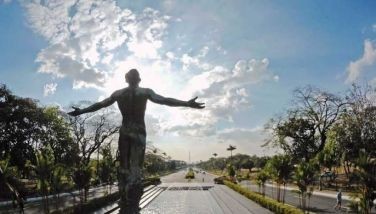This solves ‘boundary,’ crowding in public buses

Here’s a bus scheme to end the “boundary” style of compensating drivers, keep safe distancing among riders, and ensure business viability. It entails P2.7 billion state subsidy to commuters over three months, a fraction of stimulus funds being sought from Congress.
At the core of the plan are automated fare collection and bus route rationalization. Both are required by the Land Transport Franchising and Regulatory Board in memo circular 2020-019 of May 14, “Guidelines for Operation of PUBs During the Period of GCQ in Metro Manila.”
For health safety, buses can take in only half the usual riders. Operators willingly may defer profits, but not incur negative cash flow. Public transport also must modernize. Melding those concerns, topnotch engineers of the Transportation Science Society of the Philippines (TSSP) crafted the plan, “Public Transport After ECQ.”
How it works:
• Riders buy beep cards like those for LRT-1 and -2. On boarding they tap the card to register the originating stop, then tap again on alighting at destination. The usual per-kilometer fare is deducted from the card load. At day’s or weekend the total revenue electronically is relayed to the government agency in charge. The commuter fare subsidy is then remitted to the operator’s bank account.
• The operator is reimbursed the revenue lost due to less allowed riders. If the rider limit is 50 percent, the subsidy is the same amount as the total revenue for the day, to make up for the lost half. What if there’s a resurgence of COVID-19 infections, and government lessens the rider limit to only 20 percent? Then the subsidy is four times the day’s revenue, to make up for the 80-percent loss.
• Riders paying cash will not be subsidized. To avoid COVID-19 infection cash-less transactions are encouraged. Not only beep cards but G-Cash, PayMaya, and other electronic wallets can be used.
• The automated fare collection system (AFCS) records data on boarding and alighting. Overloading automatically is detected. The driver or operator is fined severely, deducted from the subsidy.
• The “boundary” system, by which a driver derives a percentage of the revenue and thus overloads riders, is discarded. Instead he is paid a fixed wage for an eight-hour shift. No work no pay is retained.
• At P7,400 daily subsidy for each of the 550 buses on the EDSA loop, government will pay out P4.07 million per day, or P366 million over three months. For 4,000 buses in Metro Manila contemplated by LTFRB the subsidy is P2.7 billion for the same period.
Jitneys can be included, TSSP said, but only if they adopt AFCS for transparency. If limited to only 50 percent riders, a jitney can be given commuter subsidy of about P1,200 a day. For 100,000 jitneys in Mega Manila this would cost P10.8 billion for three months.
TSSP critiqued other proposals by or to the Dept. of Transport. “Service contracting,” for P110 billion subsidy, controversially will select only a handful of bus and jitney operators out of the tens of thousands, and needs massive performance audit by the agency in charge.
“Fuel subsidy,” P1,152 per bus and P366 per jitney per day (based on Pantawid Pasada in 2018-2019) is too costly, encourages wasteful needless trips, and is prone to theft and corrupt diversion of fuel stocks.
“Free fare,” an adjunct to service contracting, contradicts social distancing, and leads to unnecessary travel and crowding, as witnessed on free-ride days at LRT and MRT trains versus regular runs.
TSSP advocated adoption of “intelligent transport system” aside from AFCS. Via GPS bus movements can be tracked for efficient dispatching and route management, thus avoiding traffic and long waits for rides. No need for field inspectors. Real-time info screens can be set up for passengers to check arrival times of rides, routes, stops, and terminals. Train, Pasig River and Manila Bay ferry, and provincial bus schedules eventually can be incorporated.
TSSP consists of engineering PhDs and transport specialists. Full text of study on: https://m.facebook.com/story.php?story_fbid=1526089107565452&id=558897707617935&refid=52&__tn__=-R.
* * *
The DOTr has yet to restore jitney runs in Mega Manila. Supposed recruitment of hundreds of thousands of restive drivers and operators for contact tracing is mere blabber to pacify them.
What’s sure, though, is that DOTr is resuming work on the first three stations of a Metro Manila subway. It claimed in press releases and social media posts to have IATF approval.
The three stations will be in a small corner of Quezon City. Only six kilometers will be served in triangle: Quirino Highway to Tandang Sora to North Avenue. Jitneys and tricycles amply covered that route.
The cost, as publicized in ceremonial groundbreaking in Feb. 2019, is a whopping P355.6 billion. No word about increased costs of tunneling and constructing these days. Just that DOTr bigwigs want it completed by early 2022, as a legacy of the Duterte administration.
* * *
Catch Sapol radio show, Saturdays, 8 to 10 a.m., DWIZ (882-AM).
My book “Exposés: Investigative Reporting for Clean Government” is available on Amazon: Exposés: Investigative Reporting for Clean Government
* * *
Gotcha archives: www.philstar.com/columns/134276/gotcha
- Latest
- Trending



























